Exploring Bat Activity in a North East Upland Landscape: An Audiomoth Study
Author: Darren Archer
There are some places in the North East that are just too dangerous to do bat walks. One of those is the lead mine scarred landscape of Weardale. Whilst the land is open access moorland, its undulating nature; stream cut channels hidden under tussocks; protruding metal and wooden posts, make it a bit testing. All would be rejected by any risk assessment.
Inspired by ‘Bats with Altitude’ in Cumbria (Flight, 2021), using passive detectors the project demonstrated the use of high fells by all their bat species. Up until that point there had been underreporting of bats from above 500m above sea level (ASL). With a newly found fascination for bats, in particular bat calls I scoured our upland areas for suitable sites. As this was a one-person project and I only had one newly acquired Audiomoth I was going to have to be selective. Our hills and moorland are not as high, but surely the NE Pennines would also host bats after dark.
On this basis I went to see what options were possible at the end of July 2024 above Westgate. In a year, when even people who look at insects are saying, ‘where are all the insects’ the numbers and varieties in Weardale were amazing. I had never seen double figure numbers of Small Heath Butterfly before, and I found an unexpected colony of Dark Green Fritillaries.
It is wind swept moorland landscape about 450m ASL with few records of bats come from up here. Before anyone complains bats are no respecters of borders and the site I am describing, whilst in County Durham isn’t far from the lead mine scarred landscape of Northumberland. Most of the lead mine shafts are capped but, I came across some structures built into a hillside that had small gaps potentially allowing bats access underground. These gaps lead to what looked like horizontal approaches into the hillside, surely suitable for bats. It is difficult to see how far these openings go and to be fair may not be any deeper than my torch could shine.
But would this site prove to be suitable for autumn swarming?
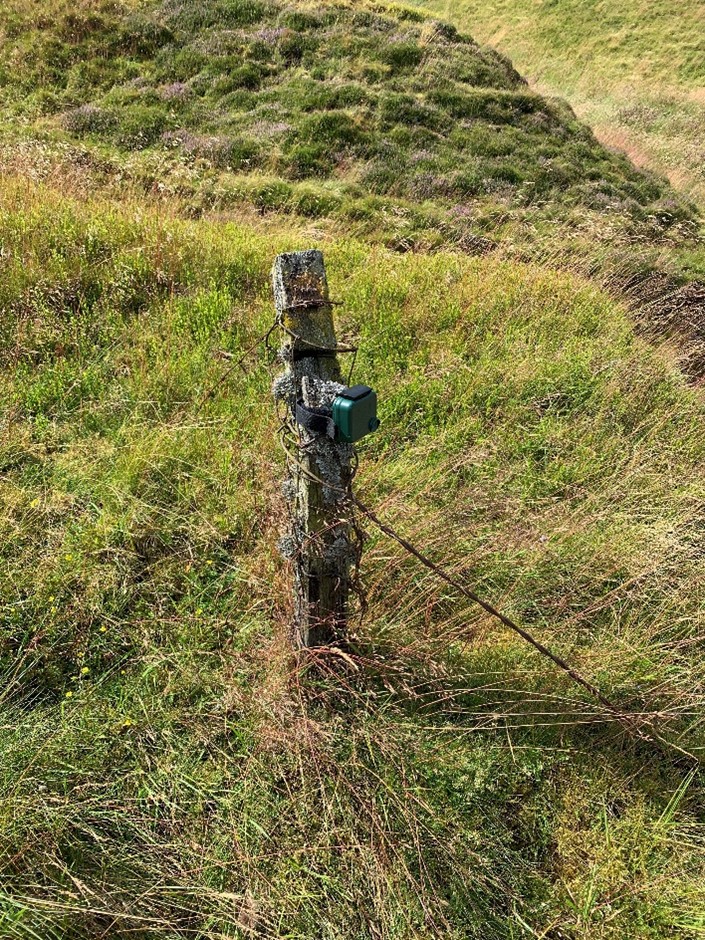
I returned the next week to site the audiomoth and collect some recordings. The best place to position the recorder was a lichen encrusted post about a metre high, overlooking a gulley -so in reality about 3m above the ground. Somerset Bat Group have useful information about the best settings required for an audiomoth. There was no one around, but I still crossed my fingers that it would still be there when I returned a week later.
It was left from 6th August -12th August 2024 and set to record 55 seconds in every minute, from 15 minutes before sunset to 15 minutes after sunrise -20:45 to 05:20. The Duracell batteries lasted until 04:20 on 12th giving me almost nearly six full nights of recording -3012 files to review. This was more than I expected and lucky as the night of 8th/9th was so wet and windy there were no bats recorded.
I had no idea what to expect when I started to review the recordings with Kaleidoscope (Lite) a free version of sound analysis software suitable for ultrasound. Being new to bats I had a naivety about what it was going to take to manually review the recordings. I consoled myself by saying I only needed more than 6.3 passes per night (Cumbrian results) to keep me happy and on track. The first night, 33 passes were enough, and I was hooked, though each night varied greatly.
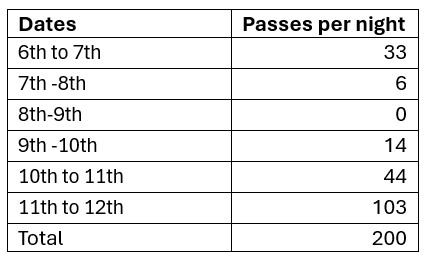
97 of the 3012 files had bat calls, some had more than one species and some it was difficult to tell if it was one bat or several. In total this amounted to 200 bat passes of 6 species plus Whiskered/Brandt’s. No surprise that 75% were Common Pipistrelle calls
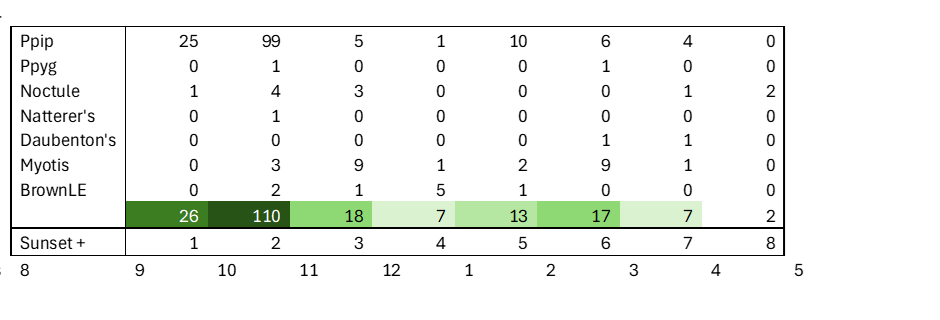
Most of the Common Pipistrelles were early in the evening suggesting the nearby farmhouse and/or its barn has a summer roost. The Myotis species and Brown long-eared tended to appear later with the Noctule early and late as I expected.
The joker in the pack was the two Soprano calls both were single isolated social calls in separate files with no echo location before or after. At first I didn’t recognise them but later in August spent time recording Ppyg at a local pond and have come to appreciate the diversity they bring to recordings.
However, the sample was only big enough to draw one significant conclusion. That was, I found this really exciting. I suddenly had a set of fascinating recordings. They were so fascinating I looked at the calendar and identified the next days when there was the least moon i.e. maximum darkness- it might make a difference according to some researchers.
A month on and sunset in September is an hour earlier than August. To last the batteries for a full week, knowing most bat activity happened in the first half of the night, I recorded from 19:45 to 03:10 -2986 files.
In August we were in a steady stream of westerly air but, by September it was mainly from the North East. It was thick mist when I left the audiomoth –2nd September. This mist came and went several nights during the week making it was difficult to know for definite what the weather in the valley was like, given its an hour’s drive from home. The only thing I knew for definite was it had rained heavily on the night of 8th/9th September.
The test for this was not the volume of water under foot as I went to recover the audiomoth, the real marker was the 6 day-hunting Barn Owls between 9:30 and 10am that had been unable to hunt overnight. My expectations for the second set of recording was suddenly set very low. This proved unfounded. There were no recordings from 5th /6th other than the wind and for some reason the audiomoth didn’t record from midnight to 3am on 9th but still it exceeded the number of August bat passes.
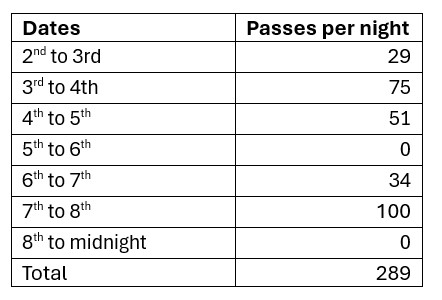
Again, Common Pipistrelles dominated the early evening. The low numbers of Myotis species reflected the damp, and sometimes windy conditions of the week. Its not worth travelling this far under these circumstances. The solo Soprano Pipistrelle call this week was an echolocation call in the same 55sec file as a Common Pipistrelle. It raises more questions about the presence of this species up here for me.

The standout species though was the Brown Long-eared. Its call, down to 1/10 normal, appears like a white cane being tapped out finding its way which has given me an image I cant now shake off. In this week it was probably under recorded too as the gusty wind created an artifact of sound at the same KHz.
I plan to try to get a couple more recordings in before the winter, all the records will go to the Northumberland County Recorder.
I haven’t included the exact site in this blog. This is not to keep it secret and prevent others going here. I have done so because upland areas in the North East are vast and bats are under-recorded away from well know roost sites. What I have learnt in my limited time thinking about bats is that these small long-lived creatures are landscape scale animals. Protecting their roost sites is critical. But so is knowing where and how they use the surrounding landscapes. For a relatively cheap outlay you can have great fun and might find things that were previously unseen.
References.
Flight, R. (2021) British Island Bats. Volume 2 pp105-127. Bats with Altitude: Determining the presence of bats in high altitude locations within the British Lake District. BritishIslandsBats_VolTwo_2021.pdf
Also Batchat Podcast December 15 2021. S3E21. Steve Roe interviews Rich Flight about this project. Bats with Altitude – Rich Flight (buzzsprout.com)
Share this post!
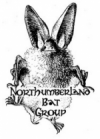
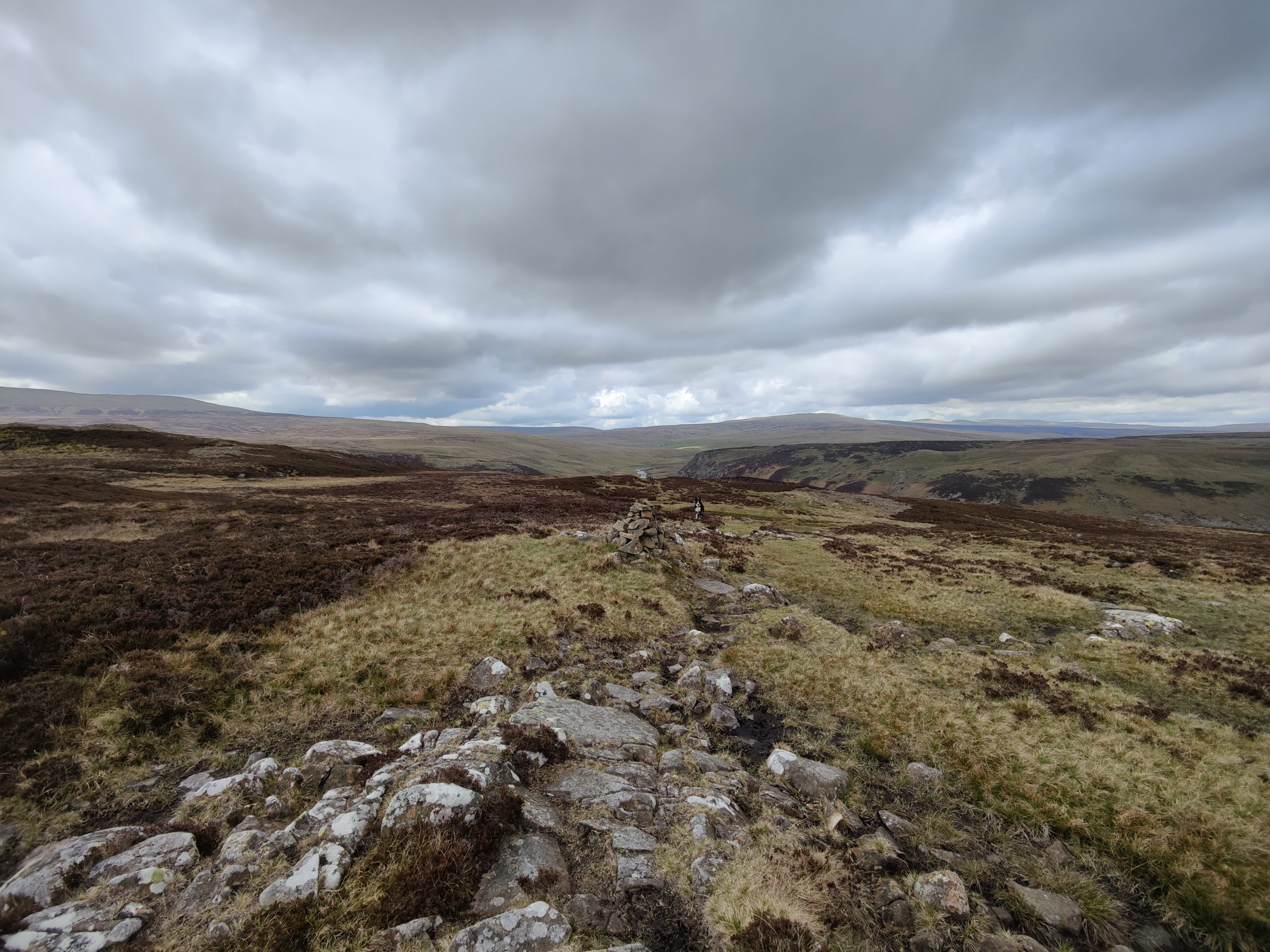
Hi Nic
i dont know if you would like an update on this blog. I have now two lots of new recordings -start of October and start of November.
The Oct ones made it into the British Island Bats paper for Tina. The November records I have just finished analysing. It looks like the Ppips are weather dependent probably a maternity colony at the farm but when the weather changed they did dramatically reduce in numbers. Brown -long eareds stayed weirdly quite high through October and November. But the big increase in November were Natterer’s going from 0.5%; 0.3%; 4% of all records to 7% from Sept through to November.